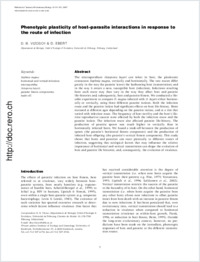Phenotypic plasticity of host–parasite interactions in response to the route of infection
- Vizoso, Dita B. Ecology and Evolution, Department of Biology, University of Fribourg, Switzerland - Institute of Zoology and Limnology, University of Innsbruck, Austria
- Ebert, Dieter Ecology and Evolution, Department of Biology, University of Fribourg, Switzerland
-
17.05.2005
Published in:
- Journal of Evolutionary Biology. - 2005, vol. 18, no. 4, p. 911-921
English
The microsporidium Octosporea bayeri can infect its host, the planktonic crustacean Daphnia magna, vertically and horizontally. The two routes differ greatly in the way the parasite leaves the harbouring host (transmission) and in the way it enters a new, susceptible host (infection). Infections resulting from each route may thus vary in the way they affect host and parasite life-histories and, subsequently, host and parasite fitness. We conducted a life-table experiment to compare D. magna infected with O. bayeri either horizontally or vertically, using three different parasite isolates. Both the infection route and the parasite isolate had significant effects on host life-history. Hosts matured at different ages depending on the parasite isolate, and at a size that varied with infection route. The frequency of host sterility and the host's life-time reproductive success were affected by both the infection route and the parasite isolate. The infection route also affected parasite life-history. The production of parasite spores was much higher in vertically than in horizontally infected hosts. We found a trade-off between the production of spores (the parasite's horizontal fitness component) and the production of infected host offspring (the parasite's vertical fitness component). This study shows that hosts and parasites can react plastically to different routes of infection, suggesting that ecological factors that may influence the relative importance of horizontal and vertical transmission can shape the evolution of host and parasite life histories, and, consequently, the evolution of virulence.
- Faculty
- Faculté des sciences et de médecine
- Department
- Département de Biologie
- Language
-
- English
- Classification
- Biological sciences
- License
-
License undefined
- Identifiers
-
- RERO DOC 5444
- DOI 10.1111/j.1420-9101.2005.00920.x
- Persistent URL
- https://folia.unifr.ch/unifr/documents/299894
Statistics
Document views: 153
File downloads:
- Texte intégral: 253
